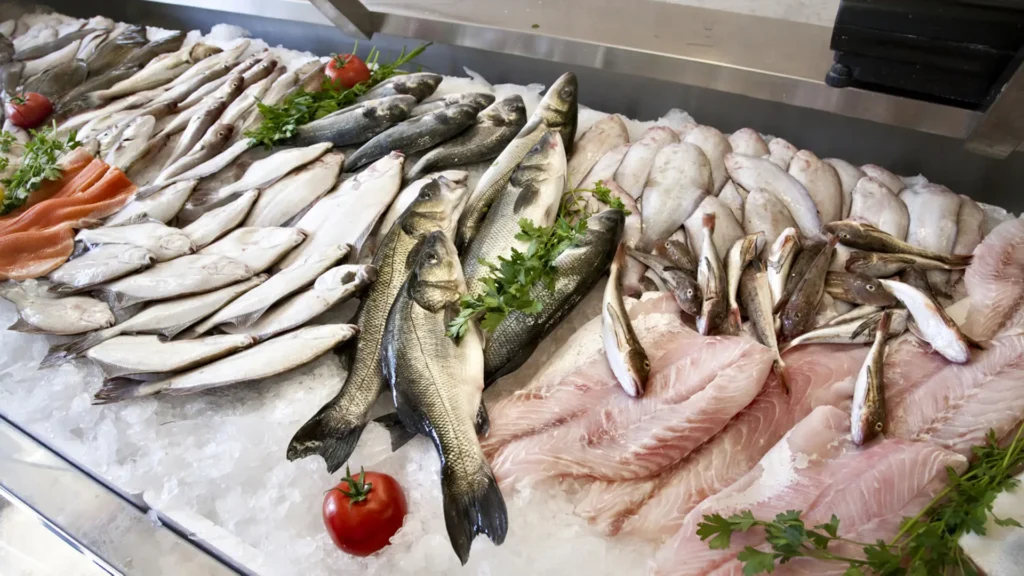As you step into the bustling aisles of your local fish market, it’s crucial to arm yourself with the knowledge of what to look for in terms of freshness and sustainability. You’ll want to eye those fish with clear, bright eyes and firm, bouncy flesh—a telltale sign they’ve just come from the water. Don’t shy away from asking vendors about the origin of their fish and the practices used in its capture or cultivation. With a well-informed approach, you’ll not only elevate your culinary experience but also contribute positively to ocean health. But how can you make an informed choice when the options are seemingly endless?
Understanding Seafood Freshness
To ensure you’re buying the best, always check that the fish’s eyes are clear and its flesh springs back when touched. These are the hallmark signs of freshness. Don’t be shy about asking the fishmonger to let you inspect the fish up close.
Fresh fish shouldn’t smell fishy; it should have a clean, briny aroma, much like the ocean. If you’re picking whole fish, the gills should be a vibrant red, not brown or slimy.
You’ll also want to look at the skin. It should be shiny and tight, without any discoloration, drying, or wrinkles. If it’s a fillet you’re after, check for firm, moist texture, and uniform color. Avoid any fillets that appear discolored or have milky, slimy liquid on the surface, as it indicates the fish is past its prime.
Evaluating Sustainability Practices
You’ll also want to assess the sustainability practices of the market to ensure they align with environmentally responsible fishing and farming. It’s crucial to understand that sustainable seafood comes from sources, either fished or farmed, that maintain or increase production without jeopardizing the ecosystems from which they were acquired.
Start by inquiring if the fish market has any certifications. Labels like MSC (Marine Stewardship Council) or ASC (Aquaculture Stewardship Council) are telltale signs of compliance with international sustainability standards. Don’t hesitate to ask for details about specific labels; a trustworthy vendor will be transparent about their products.
Another key aspect is the traceability of the seafood. Can the market trace its seafood back to its original source? Knowing where and how the seafood was caught or farmed plays a pivotal role in assessing its sustainability.
Also, consider the role of local and seasonal products. Markets that prioritize these are often more aligned with sustainable practices as they promote local economies and reduce environmental impacts associated with long-distance transportation.
Selecting Types of Seafood
Consider the variety of seafood available at your local market and choose species that are both flavorful and sustainable. When you’re perusing the icy displays, don’t just go for the usual suspects like salmon or shrimp. Why not try a fillet of mackerel or a serving of sardines? These options are often overlooked, yet they pack a punch in terms of taste and are excellent choices for the environmentally conscious.
Opt for wild-caught if possible, which often signifies a lesser impact on aquatic ecosystems compared to some farming methods. However, there are exceptions. Certain farmed species, such as tilapia and barramundi, are raised in sustainable systems designed to minimize environmental damage.
Don’t hesitate to ask for recommendations too. Your fishmonger can provide invaluable insights into the freshest catches and ethical choices. They might even suggest cooking methods that best suit each type of seafood, ensuring you get the most out of your purchase. Remember, making informed choices not only enhances your dining experience but also contributes to the health of our oceans. As you explore your local fish market, remember to look for freshness indicators like clear eyes and springy flesh.
Make sustainability a priority by choosing MSC or ASC-certified seafood, and don’t shy away from exploring diverse and sustainable options such as mackerel or sardines.
Embrace both wild-caught and responsibly farmed fish to ensure you’re making choices that are good for the ocean and your dinner table.
Learn more:
Top Tips for Bargain Hunting at the Best Fish Markets Near You
Ultimate Guide to Selecting Fresh Seafood at Your Local Fish Market

